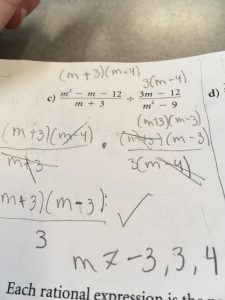This week I learned how to multiply and divide rational expressions by factoring to get the restrictions for only the denominator.
My example is how to divide rational expressions. The first step is to factor, the second step is to state the restrictions, the third step is to flip over the fraction (reciprocal) and multiply from across to bottom. Then scratch out what is common and whatever is left that is your answer. I find this really easy because I love working with fractions and it is not that complicated. I find multiplication easier than dividing because then you can factor the expressions and then state your restrictions and the last step to multiply and scratch out the common expressions. There is no reciprocal required. And in my example there is a difference of squares so the factored form will be conjugates which is really easy. With this unit factoring is the key component because it tells the most important part the restrictions for x or any variable.

My division example that I used and simplified.